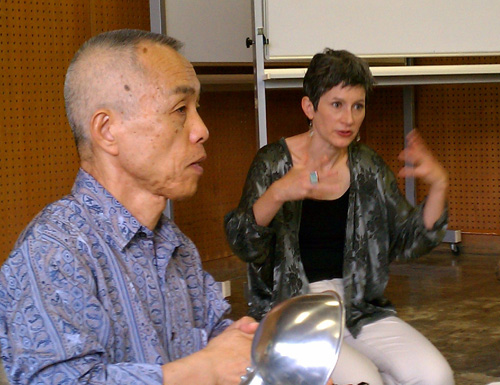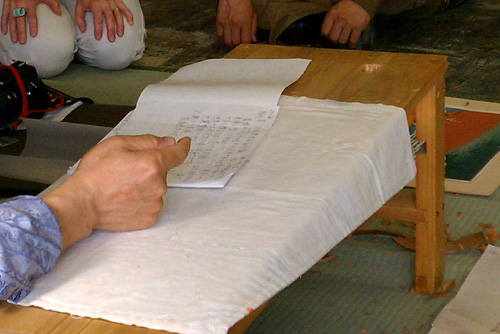Today's postings
- [Baren 43612] no more paper! (Linda Beeman)
- [Baren 43613] Re: no more paper! (David Bull)
- [Baren 43614] Re: no more paper! (David Bull)
- [Baren 43615] Baren Member blogs: Update Notification (Blog Manager)

Message 1
From: Linda Beeman
Date: Thu, 23 Jun 2011 01:17:58 GMT
Subject: [Baren 43612] no more paper!
Send Message: To this poster
I just looked up my usual paper from the Baren Mall and find all the sheet papers discontinued! I am distraught!
Linda
Check out my blog!
http://lindabeemanprintmaker.blogspot.com

Message 2
From: David Bull
Date: Thu, 23 Jun 2011 01:25:31 GMT
Subject: [Baren 43613] Re: no more paper!
Send Message: To this poster
> sheet papers discontinued! I am distraught!
Linda, the situation is 'fluid'. Due to a recent problem with a large
batch of paper, and the subsequent issues with 'returns', etc., we've
had to shut down the ordering of paper through Matsumura-san.
We're looking for an alternative supplier, and may have something to
report soon ...
Thanks for patience on this!
Dave

Message 3
From: David Bull
Date: Thu, 23 Jun 2011 01:59:51 GMT
Subject: [Baren 43614] Re: no more paper!
Send Message: To this poster
> report soon ...
Actually, now that this has become a public issue here on Baren, I
should ask for some input here.
Before I start doing the 'data mining' on the 10+ years of Baren Mall
orders, can those of you who have come to use the papers we supplied
there give me some feedback?
Which of the papers have you used extensively, and found to be most
useful in your work? We're looking for replacements, so it would help
us a lot if we knew what you need ...
The original list is here (but you can no longer order these from
us ...):
http://www.barenforum.org/mall/products/paper_old.php
TIA!
Dave
Digest Appendix
Postings made on [Baren] members' blogs
over the past 24 hours ...
Subject: Mokuhanga Conference 4 - Carving the Ineffable
Posted by: Annie B
While Sato san was demonstrating Kyoto-style woodblock printing in one part of the large room at Kyoto Kaikan, a carver named Hiroshi Fujisawa was demonstrating traditional carving. Fujisawa san is a professional carver who works in a home-based workshop in Kyoto. He was an apprentice beginning at age 16 to master carver Kikuta Kojiro and has now been carving for over 50 years. He is said to be one of the best carvers in Japan. Fujisawa san speaks while Claire translates By the time I made it over to Fujisawa san's demonstration, he had finished carving and was giving a talk about how his study of Buddhism informs his work. In his talk he used the words kokoro (?) meaning heart/mind/spirit and kuuki (??) which means atmosphere/mood/tone. He spoke about the importance and the difficulty of representing these qualities, the heart of the artist and the tone of a place, in a print. As he spoke, I thought about the "kokoro" and "kuuki" in my own work. I thought about how I've been using mokuhanga to express my thoughts and feelings (kokoro) about my country, about religion, about the uneasy international relationships of this early global 21st century. I thought about how I often surround myself with music or audio books or podcasts that have to do with the topic or the time period I'm working with, an attempt to create the "kuuki" of a time and place in my studio while I work. I've always felt that somehow those feelings and songs and words and ideas that I'm immersed in, the emotional/mental/spiritual energy I use to create my work, become embedded within it and are readable by the viewer, however subtly.  Fujisawa san's beautiful notes It seemed to me that Fujisawa san was saying that something inherent in mokuhanga allows these invisible and ineffable qualities to be expressed, that something about the method itself allows this process of embedment to occur. My answer to what it is about mokuhanga that allows these ineffable qualities to appear would be the following list. - The slowness of the method allows (or forces) one to go deeply into the work. - The tradition and history attached to the techniques and tools give them an almost ritualistic quality. - The deconstruction of an image required in separating the colors onto different pieces of wood and then putting them back together into a new form offers many opportunities for the artist to react and respond to the materials in the process, embedding new decisions in the "memory" of the printed image. - A woodblock artist uses her whole body to make the work. There is a very physical wrestling with the resistance of the wood in order to carve an image, and printing with a baren instead of a press also requires a lot of physical energy. The artist's body is part of the print. Of course, some of these qualities are not unique to mokuhanga. I'd love to hear from you readers who work in other media -- do you, and if so, how do you express these ineffable qualities in your work? Please leave a comment if you have thoughts about this. [Long item has been trimmed at this point. The full blog entry can be viewed here] |
This item is taken from the blog woodblock dreams.
'Reply' to Baren about this item.
Subject: Spring 2012
Posted by: JennifersCabin
This item is taken from the blog Jennifer Martindale.
'Reply' to Baren about this item.
Subject: After the Fabric comes the Dress
Posted by: Sharri
|
Printing the "Fabric of the Gulf" (see the previous post) and working with this delicious Japanese paper, the desire to attempt to sew it up into something was too much temptation to resist. With that in mind I found a cheap pattern and went home ready to print and sew and that I did. While at the fabric store a few days later looking for black satin to fashion a slip and oil spill for this piece, I ran into Ross Dress for Less (conveniently located next door) and ran into the most perfect dress form in a size and shape unknown to any human female. I grabbed that baby and stuffed her into my cart so fast it made my head spin. And, when I got her home she perfectly fit the dress which is a more or less size 4. A Great Debate followed as to whether or not my new model needed a slip. I finally decided it made a much stronger piece with a black background for this transparent paper. With every piece we do we should learn something which will make the next piece we do even better, right? Well, I learned so much on this one that my next venture should be a real doozy. And to give you a little closer look:
here]
|
This item is taken from the blog Rag & Bone.
'Reply' to Baren about this item.
Subject: When The Demon Knife Weeps
This item is taken from the blog Against the grain.
'Reply' to Baren about this item.

